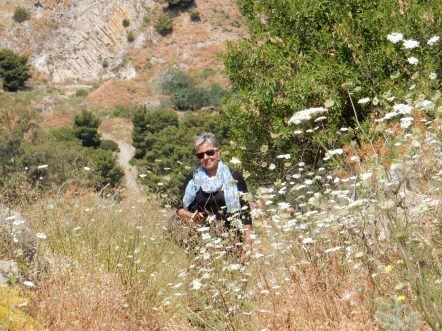
Η Παλαιοχώρα, η ίδρυση της οποίας τοποθετείται στο 896 μ.Χ., σήμερα είναι μια μικρογραφία του Μυστρά με εκκλησίες και ερείπια από σπίτια. Σωζονται μόνο οι εκκλησίες και οι τοιχογραφίες τους δεν είναι σε καλή κατάσταση.
Ο λόφος έσφυζε από ζωή και οι κάτοικοι ασχολούνταν με τη γεωργία και το εμπόριο ως το 1537 μ.Χ., οπότε ο διαβόητος πειρατής Χάιρ-εδ-διν Βαρβαρόσσα λεηλάτησε και ρήμαξε τον οικισμό, γκρεμίζονας τα πάντα εκτός από τις εκκλησίες. Το 1654 μ.Χ. η Παλαιαχώρα καταστράφηκε εκ νέου και ερημώθηκε, αυτή τη φορά από τους Ενετούς.
Περίπου τριάντα πέντε εκκλησάκια στολίζουν το λόφο στις μέρες μας και είναι οι σιωπηλοί μάρτυρες της πολυκύμαντης ιστορίας του.
Η εκκλησία του Αγίου Νικολάου του Μαύρικα (13ος αιώνας) βρίσκεται σε μικρή απόσταση από το λόφο της Παλαιοχώρας. Η διακόσμηση είναι μια σειρά από τοιχογραφίες μερικές απο τις οποίες χρονολογούνται στο 1330.
Δίπλα βρίσκεται η εκκλησία του Σταυρού που γιορτάζεται στις 14 Σεπτεμβρίου και αριστερά, πιο ψηλά, είναι η Βασιλική του Αγίου Γεωργίου του Καθολικού, που αργότερα ονομάστηκε Παναγία η Φορίτισσα.
Συνεχίζοντας συναντάμε το Καθεδρικό ναό του Αγίου Διονυσίου, ο οποίος ήταν Επίσκοπος του νησιού από το 1576 μέχρι το 1579. Ο Άγιος ζούσε σε ένα κελί που σώζεται μέχρι σήμερα.

Νοτιότερα υπάρχει ένα εκκλησάκι που είναι αφιερωμένο στην Αγία Άννα. Άλλη Εκκλησία που συναντάμε είναι της Επισκοπής, μια θολωτή Βασιλική, η οποία έχει χτιστεί μέσα στον βράχο.
Από το κελί του Αγίου Διονύσιου, ένα μονοπάτι κάνει το γύρο του λόφου, περνώντας από το Εκκλησάκι των Αγίων Θεοδώρων και από την Εκκλησία των Ταξιαρχών, που βρίσκεται κάτω από αυτό.
Το Μοναστήρι της Αγίας Κυριακής ήταν το κέντρο της Παλαιοχώρας από τον 17ο αιώνα και μέχρι το 1830. Η Αγία Κυριακή είναι μια διπλή Βασιλική, με θαυμάσιες τοιχογραφίες.
Κάτω από την Αγία Κυριακή, το μονοπάτι οδηγεί στη σταυροειδή Εκκλησία του Αγίου Ιωάννη του Θεολόγου, με ένα μπλε θόλο και ένα μπλε καμπαναριό.
Το μονοπάτι συνεχίζει και ανεβαίνει στη Βασιλική των Αγίων Αναργύρων, που έχει προς τα δεξιά της ψηλότερα, την Εκκλησία του Αγίου Δημητρίου και αριστερά και κάτω το Εκκλησάκι της Κοίμησης της Θεοτόκου.
Πάνω από το μονοπάτι είναι η Εκκλησία της Μεταμόρφωσης, της οποίας σώζεται όλη η τοιχογραφία του Ιερού. Επιστρέφοντας στο κυρίως μονοπάτι βρίσκουμε την Εκκλησία του Αγίου Γεωργίου.

















Thanks for sharing! I love discovering new places. Happy to see you in the pictures 💕💕
LikeLiked by 1 person
Kisses !!! Thank you !! We are real people and i like to know each other in real life!!!
LikeLiked by 1 person
A very archaeological place to be.
LikeLiked by 1 person
Paleachora**, which means literally, “Old Town”, and which was for a millennium (9th century – early 19th century AD) the island capital.
Thank you Tony for reading my post!!!
LikeLiked by 1 person
U are always welcome dear. Greetings from Rome
LikeLiked by 1 person
Can you explain me what does mean Chinedu ikechukwu????
LikeLiked by 2 people
sure why nt. I am a Nigerian. The two names are my native names. Chinedu means “God leads; God is the leader. Ikechukwu means ” THe power of God.”
LikeLiked by 2 people
Thank you !!! I like it !! Have a nice week my friend!!!
LikeLiked by 1 person
I wish u the same, hoping to visit Anthens the year
LikeLiked by 1 person
Why not??? I have visited Milano some years ago but i want to visit Italy again!!!!
LikeLiked by 1 person
Waooooo! that is great. Will be happy to welcome you
LikeLiked by 2 people
Thank you me too!! Our countries are so beautiful and have many commons !!
LikeLiked by 1 person
Great
LikeLiked by 1 person
great
LikeLiked by 1 person
LikeLiked by 1 person
okay I will
LikeLiked by 1 person
Reblogging this to my readers at sister site Timeless Wisdoms
LikeLiked by 1 person
Thank you Ana!!! Good morning from Athens!!!
LikeLike
You’re welcome! Good morning from California!
LikeLiked by 1 person
Pingback: Paleochora: The insular “Mystras” – Timeless Wisdoms
Ωραίες οι ανοιξιάτικες σου βόλτες, πάντα τέτοια όμορφα εύχομαι! 😛
ΑΦιλάκια ηλιόλουστα και χαμογελαστά! 🙂
LikeLiked by 2 people
Kαλημέρα όλη μέρα μαγισσούλα!!!!
LikeLike
Gorgeous place!👌
LikeLiked by 2 people
Ι will visit it in April again and i will post the blossom of its flowers !!! Kisses!!!
LikeLiked by 1 person
Reblogged this on WORLD OF CREATIVITY and commented:
Nice write up
LikeLiked by 1 person
Thank you Tony!!! Have a nice day!!!!
LikeLiked by 1 person
Good morning from Italy. You are welcome
LikeLiked by 1 person
Such a beautiful place, Efi 🙂 🙂 I hope your week is going well?
LikeLiked by 1 person
Budding trees and flowers, spring peepers singing, daffodils, newly arriving bird species, nest building, caterpillars, , rainy days, worms on the sidewalk, baby animals, people cleaning their yards, forsythia, magnolias, windy days, songbirds singing, blooming fruit trees, butterflies, people not wearing jackets ….. SPRING is HERE Jo!!!!!!!!!!!!
Good morning from Athens!!!
LikeLike
Kalimera, Efi 🙂 🙂 xxx
LikeLiked by 1 person
Great to read and learn about these places…Lovely pictures of you!
Have a nice day dear 💜
LikeLiked by 1 person
Sending back a big heap of hugs!!!!
LikeLike